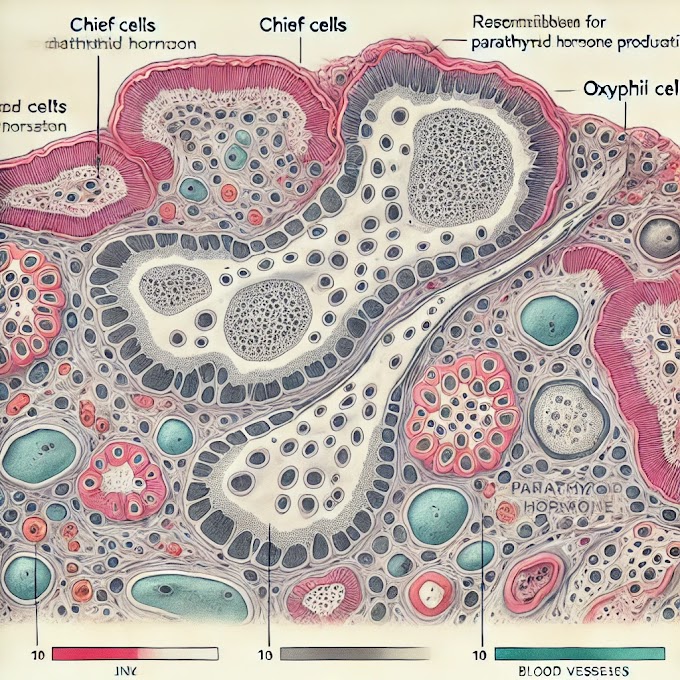Under The Light Microscopic View
This histology slide shows elastic cartilage, specifically from the external ear (pinna). Here is a description of each marked area:
Stratified Squamous Keratinized Epithelium (marked in yellow at the top left):
- This outermost layer is made up of multiple layers of squamous cells with keratin on the surface, providing protection to the underlying tissue.
Hair Follicle (marked in orange):
- Hair follicles are visible in the skin overlying the cartilage, responsible for hair growth.
Gland (marked in red):
- Small glands, such as sebaceous or sweat glands, are seen near the hair follicle, contributing to lubrication and moisture.
Perichondrium (marked in green):
- A dense connective tissue surrounding the cartilage that provides nutrients and support.
Matrix with Elastic Fibers and Lacunae (marked in purple):
- The matrix of elastic cartilage is embedded with elastic fibers and contains lacunae, where chondrocytes reside. This gives the cartilage flexibility and resilience.
Connective Tissue and Gland (marked in blue):
- The connective tissue is composed of collagen fibers and cells, while nearby glands support various functions like moisture control.
Three Key Identification Points for Elastic Cartilage
- Elastic Fibers in the Matrix: Unlike hyaline cartilage, elastic cartilage contains a dense network of elastic fibers, providing flexibility.
- Presence of Perichondrium: Elastic cartilage has a surrounding layer of perichondrium for support and nutrient supply.
- Location and Flexibility: Commonly found in flexible structures like the external ear, allowing bending and resilience without permanent deformation.
Elastic cartilage provides structural support with flexibility, crucial for parts of the body like the ear and epiglottis.
elastic cartilage histology slide, showing the marked areas like stratified squamous keratinized epithelium, hair follicle, glands, perichondrium, elastic fibers, and lacunae.
Identifying histological features on an elastic cartilage slide involves examining the tissue under a microscope. Here are key points to look for when identifying structures in elastic cartilage histology slides:
Chondrocytes:
- The main cell type in elastic cartilage, similar to hyaline cartilage.
- Located within lacunae.
Extracellular Matrix:
- Contains elastic fibers (mainly elastin) in addition to collagen fibers, proteoglycans, and water.
- Appears more opaque and flexible compared to hyaline cartilage.
Elastic Fibers:
- Prominent throughout the matrix, providing elasticity to the cartilage.
- Stain less intensely than collagen fibers.
Lacunae:
- Small spaces within the matrix that house individual chondrocytes.
Perichondrium:
- May or may not be present in elastic cartilage.
- If present, it may have an outer fibrous layer and an inner cellular layer.
Capsule (Perichondrial Fibrocartilage):
- If the perichondrium is present, it may have a fibrous outer layer and an inner layer with chondroblasts.
Isogenous Groups:
- Clusters of chondrocytes derived from a single parent cell.
- Often seen in lacunae close to each other.
Territorial Matrix:
- The matrix immediately surrounding individual lacunae, with a higher concentration of proteoglycans.
Interterritorial Matrix:
- The matrix between lacunae and territorial matrices, with a lower concentration of proteoglycans.
Blood Vessels:
- Elastic cartilage is typically avascular, like hyaline cartilage.
Nerve Fibers:
- Elastic cartilage is not highly innervated.
Specialized Structures:
- Elastic cartilage is often found in structures that require elasticity, such as the epiglottis and external ear.
- Click Here To Watch Videos On My Youtube Channel Ikrambaig@Tech
written by: ikrambaigtech
Click here for download
Facebook page Focus click below 👇
Quora page link below 👇 image
🆓 Video download click here




















0 Comments